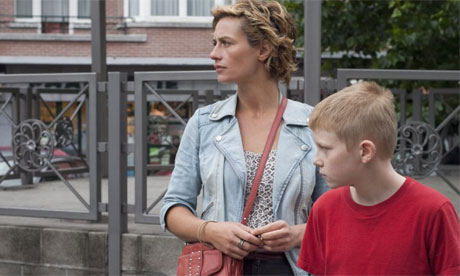Multi-hyphenates Jean-Pierre and Luc Dardenne's The Kid with a Bike (Le gamin au vélo, 2011), awarded with a share of the Grand Prix at Cannes this past May - the Belgian filmmakers' fifth consecutive citation at the showcase - provides a conspicuously convergent and no less rich companion piece to Aki Kaurismäki's FIPRESCI prize-winner Le Havre (2011), albeit one that displays the brothers' very different concerns from their humanist fellow-traveler. Composed of the same bold, primary color palette as the Finnish maestro's latest, particularly on the level of Maira Ramedhan Lévy's costume design - Thomas Doret's eleven year-old protagonist Cyril goes nowhere without his bright red windbreaker or a similarly hued 'T'; guardian Samantha (Cécile De France) with her light-blue jean jacket or at the very least a visible teal bra-strap - The Kid with a Bike similarly focuses on an at-risk male youth, the aforesaid Cyril, who finds a savior in a charitable stranger. While the eminently secular Kaurismäki's film finds its subject matter in the controversial, and naturally trendy politics of immigration, the culturally Christian Dardennes look to the no less individually vital though far less sexy milieu of predatory, under-class gangs. In The Kid with a Bike, the Dardennes simply but scrupulously map the personal appeal of this criminal sub-culture to Cyril, with the charismatic young Wes (Egon Di Mateo), in an unexpected nod to Wesker in Resident Evil: Afterlife (2010), fulfilling the role of surrogate father; Wes in essence replaces the former's deadbeat dad, longtime Dardennes collaborator Jérémie Renier, in a role that abounds with private self-reference. In the end, it is left to proxy single-mother Samantha to combat the archetypal underclass neighborhood threat. The Kid with a Bike in this sense trades in myth, in the universal, as opposed to Le Havre's concrete particularity.
In one significant, theoretical sense, however, the Dardennes' latest is more specific than the Kaurismäki: as a work of uniquely cinematic art. From the film's opening, hand-held, long-take framing - a strategy that proves ubiquitous throughout The Kid with a Bike - the Dardennes and cinematographer Alain Marcoen depict the anguished Cyril's perpetual motion. Their camera follows the child with great precision as he avoids capture, first in the group home and consequently in Samantha's place-of-residence; as he races after the same bicycle thief twice (in the film's most obvious set of inter-cinematic references); and above all, as he whips across the thoroughfares and glides down the side-streets of the small Belgian city, on his eponymous bike. With the filmmakers' kinetic camera - in contrast to Kaurismäki's more commonly static set-ups - rigorously identifying with the consistently mobile Cryil and reactive Samantha, The Kid with a Bike in effect becomes all movement, which is to say in the classical film theory sense, all cinema.
The Kid with a Bike will screen twice at the New York Film Festival, Thursday, October 6 at 6:00 PM and Friday, October 7 at 9:00 PM. Sundance Selects has acquired the film for North American distribution.

No comments:
Post a Comment